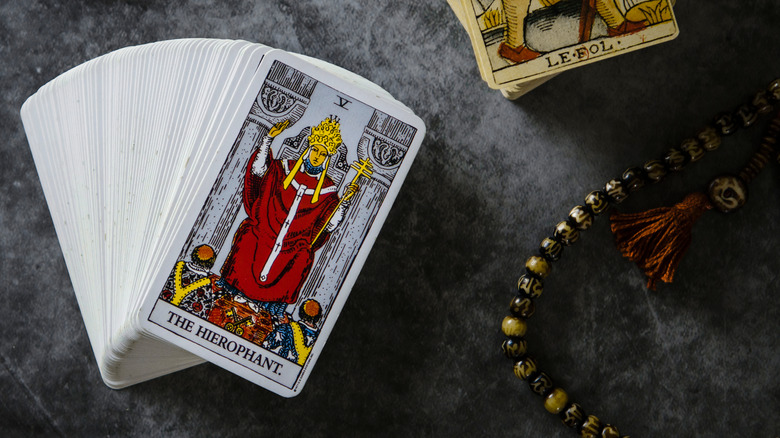What Does The Hierophant Card Mean In Tarot?
So, you drew the Hierophant tarot card, now what? The key to understanding what your tarot card means is often hidden in the illustrations.
In traditional tarot decks, based on the Rider-Waite deck, the Hierophant is portrayed sitting between two pillars with two fingers on his right hand pointing towards heaven, according to Tarot.com. He is also seen in front of two supplicants with a pair of keys crossed at his feet. The Hierophant is portrayed wearing three robes, a three-tiered crown, and carries the Papal Cross — a triple cross — in his left hand. It is the fifth card in a tarot deck and part of the Major Arcana as well.
The use of three in groupings carries over into contemporary versions of the Hierophant tarot card as well. In Claire Goodchild's "The Antique Anatomy Tarot" deck, the Hierophant is a simple design with a single femur bone standing in the center with three smaller bones, also femur-shaped, laying across it. From where the bones intersect, the leaves of a salal plant grow — with six leaves, to be exact. The focus of Goodchild's deck shows the femur bone at the center, which historically symbolizes "strength, power, support, and regeneration" (via A Seeker's Thoughts).
One of the keys to understanding the Hierophant card is the numbers that show up. Three, for example, is known in tarot for symbolizing "expansion, groups, and growth," according to Goodchild. Since the Hierophant tarot card is also the fifth in the deck, it is associated with "isolation, conflict, and perspective."
What the Hierophant card means can depend on your tarot deck
Claire Goodchild explains in the book that accompanies the "The Antique Anatomy Tarot" deck she designed that the Hierophant tarot card appears in readings when you need help problem-solving. The person the Hierophant represents isn't necessarily anyone having to do with religion, but can just be a teacher or friend who you can go to as a sounding board for whatever you're trying to deal with. When pulled, you may be in a situation that you're not ready to handle on your own, and there's nothing wrong with that. Looking outside yourself for help — aka a new way of looking at things — is brave.
Biddy Tarot's explanation of the Hierophant takes the more traditional approach to reading tarot cards. Leaning heavily on the spiritual or religious aspects, Biddy explains that the Hierophant "represents an established set of spiritual values and beliefs" whose principles should be learned "from a trusted source." This extends into tradition as well, whether it be religious, family, or academic. The Hierophant card is telling you it's okay to be traditional, to explore your religious heritage, and to find a physical place you belong to that helps you grow physically and mentally.
Reversed, the Hierophant is reminding you that you are your own best teacher. For whatever situation you're in, this isn't one you need outside validation for. Even if the answer to your question takes you away from tradition, that's okay. The Hierophant is telling you it's okay to make your own rules.

